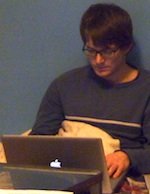
|
|
|
Conférenciers invités
 Guillem Rigaill, SPS Paris-Saclay Guillem Rigaill, SPS Paris-Saclay Tutoriel sur l'apprentissage de réseaux biologiques.
Learning ecological networks -benefits and perspectives. The ecosystem services concept is being used increasingly to attach values to natural systems and the multiple benefits they provide to human societies. ES have social and economic value and this should assure an explicit connection between the natural and social sciences, but ES approaches have been criticized for retaining little natural science context. Network-based approach to transcend these discipline challenges and place the natural science context at the heart of ES research. Despite their potential benefits, however, building ecological networks using conventional observation approaches is highly costly. Using network learning approaches could greatly increase the rate and coverage of ecological network construction. In this talk I will cover some of the areas of ecological research that would benefit greatly from learning approaches and in turn have benefits for the management of our ecosystems and environment.
Sobol sensitivity analysis.Recent statistical result overview. Kick and follow for network construction
Tutoriel sur statistique et apprentissage de réseau.
Tutoriel : Méthodes exactes d'optimisation pour l'apprentissage de structure de réseaux Bayésiens en vue de reconstruire des réseaux de régulation de gènes.
 Corinne Vacher, INRA Bordeaux Corinne Vacher, INRA BordeauxLearning microbial networks from NGS data: a case example. All animals and plants establish symbiotic relationships with microorganisms. These microorganisms interact with their host, and with each other. A current challenge is to decipher these complex and dynamic microbial networks that—contrary to more conventional trophic networks for which a well-developed theory exists—contain various types of interactions among microorganisms from various kingdoms. Another challenge is to understand how these interactions regulate the growth rate and fitness of pathogens and to use these findings to improve disease management strategies. Next-generation sequencing (NGS) techniques can be combined with network learning and modelling to discover potential relationships between microorganisms. Here, I will present a case study in which associations and interactions between a plant pathogen and the residential microbial community have been revealed with NGS.
 Alexander Bockmayr, Freie Universität Berlin Alexander Bockmayr, Freie Universität Berlin
Dynamic optimization of metabolic networks coupled with gene expression. Adjusting the metabolic network organization to the environment by tuning enzyme expression levels is crucial for cellular growth, in particular in a changing environment or during metabolic adaptation. Metabolic networks are often studied with optimization methods applied to constraint-based steady-state models. But, a corresponding dynamic modeling framework including a tight interplay between metabolic fluxes and gene expression is currently lacking. Due to that, the cost of producing enzymes so far could not be taken into account in dynamic optimization of metabolic fluxes. Here, we present a modeling framework combining the metabolic network and the enzyme production costs. Model reduction using timescale separation yields a coupled model of quasi steady-state constraints on the metabolic reactions, and differential equations for the substrate concentrations and biomass composition. Based on this model, we propose a dynamic optimization approach to determine reaction fluxes, explicitly taking production costs for enzymes and enzymatic capacity into account. In contrast to the established dynamic flux balance analysis, the proposed approach thereby allows to analyse dynamic changes in both the metabolic fluxes and the detailed biomass composition in situations of metabolic adaptation.
Inferring and analysing the gene regulatory networks involved in plant root development.
|






